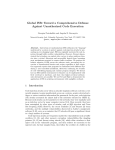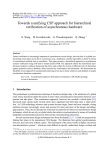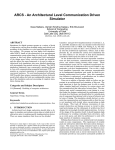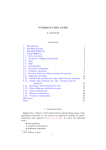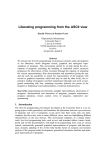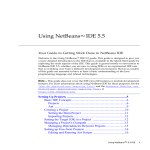Download The design of an asynchronous Tiny RISC TM/TR4101
Transcript
Downloaded from orbit.dtu.dk on: Dec 17, 2015 The design of an asynchronous Tiny RISC TM/TR4101 microprocessor core Christensen, Kåre Tais; Jensen, P.; Korger, P.; Sparsø, Jens Published in: Advanced Research in Asynchronous Circuits and Systems, 1998. Proceedings. 1998 Fourth International Symposium on DOI: 10.1109/ASYNC.1998.666498 Publication date: 1998 Document Version Publisher final version (usually the publisher pdf) Link to publication Citation (APA): Christensen, K. T., Jensen, P., Korger, P., & Sparsø, J. (1998). The design of an asynchronous Tiny RISC TM/TR4101 microprocessor core. In Advanced Research in Asynchronous Circuits and Systems, 1998. Proceedings. 1998 Fourth International Symposium on. (pp. 108-119). IEEE. 10.1109/ASYNC.1998.666498 General rights Copyright and moral rights for the publications made accessible in the public portal are retained by the authors and/or other copyright owners and it is a condition of accessing publications that users recognise and abide by the legal requirements associated with these rights. • Users may download and print one copy of any publication from the public portal for the purpose of private study or research. • You may not further distribute the material or use it for any profit-making activity or commercial gain • You may freely distribute the URL identifying the publication in the public portal ? If you believe that this document breaches copyright please contact us providing details, and we will remove access to the work immediately and investigate your claim. The Design of an Asynchronous TinyRISCTM TR4101 Microprocessor Core Kare T. Christensen 1) 1) Peter Jensen Department of Information Technology Technical University of Denmark DK-2800 Lyngby, Denmark e-mail: fktc, [email protected] Abstract This paper presents the design of an asynchronous version of the TR4101 embedded microprocessor core developed by LSI Logic Inc. The asynchronous processor, called ARISC, was designed using the same CAD tools and the same standard cell library that was used to implement the TR4101. The paper reports on the design methodology, the architecture, the implementation, and the performance of the ARISC. This includes a comparison with the TR4101, and a detailed breakdown of the power consumption in the ARISC. ARISC is our rst attempt at an asynchronous implementation and a number of simplifying decisions were made up front. Throughout the entire design we use four-phase handshaking in combination with a normally opaque latch controller. All logic is implemented using static logic standard cells. Despite this the ARISC performs surprisingly well: In 0.35 m CMOS performance is 74-123 MIPS depending on the instruction mix, and at 74 MIPS the power eciency is 635 MIPS/Watt. 1 Introduction Recent research has demonstrated that asynchronous techniques have matured and can be used to design circuits of industrial complexity with low power consumption [17, 18, 4, 14, 13]. In order to gain broader acceptance of asynchronous techniques, it is necessary to extend the knowledge base on where and how asynchronous design can be exploited to advantage and this calls for more design experiments. Furthermore, CAD tools supporting asynchronous design has to be developed and embedded in standard commercial CAD tool frameworks. In this paper we report on a design experiment that address both issues. Specically, the paper reports on an asynchronous Peter Korger 2) 2) 2) Jens Spars 1) LSI Logic Denmark Lautrupvang 2B DK-2750 Ballerup, Denmark e-mail: fpeterj, [email protected] re-implementation of the TinyRISCtm TR4101 embedded microprocessor core [6] developed and marketed by LSI Logic Inc. as part of their CoreWare macro cell library [5]. The TR4101 implements the MIPS-II and the MIPS16 instruction sets [9, 8]. The asynchronous re-implementation, called ARISC, was designed from scratch in a 1 man-year eort over a period of 5 months, in a joint project between the Technical University of Denmark and LSI Logic Denmark [1]. The work was carried out within LSI Logic using the CAD-tools and standard cell libraries available in that organization. The end result of this work is a placed and routed standard cell layout from which speed and power gures have been extracted. The paper makes several contributions. It demonstrates how asynchronous design is feasible in a traditional CAD tool environment based on the Verilog hardware description language and the Synopsys synthesis tool. These tools were used to describe the design and to synthesize the data-path logic. The (speed-independent) asynchronous control logic was designed partly by hand and partly by using the tool Petrify [2]. Furthermore, the paper develops a simple and ecient architecture whose implementation performs better than the TR4101. Given that the latter is a highly optimized design and that the ARISC is a quick rst attempt at an asynchronous implementation (with signicant room for improvement), this is a promising result. The paper reports speed and power measures for the ARISC and compares these with the TR4101. Finally, the paper gives a detailed breakdown of the power consumption of the ARISC, thereby providing some hints for further improvement and some guidelines for asynchronous design in general. The paper is organized as follows. Section 2 gives a brief description of the TR4101 microprocessor core. Authorized licensed use limited to: Danmarks Tekniske Informationscenter. Downloaded on June 01,2010 at 11:07:41 UTC from IEEE Xplore. Restrictions apply. Figure 2: TR4101 pipeline Figure 1: TR4101 in a typical system. Section 3 describes the design methodology used in the design of ARISC, and following this section 4 describes the RTL level architecture of the ARISC. Section 5 provides some information about the physical implementation and section 6 presents the results i.e. the speed and power measures. This is followed by a discussion of the experiences and results in section 7. Finally, section 8 concludes the paper. 2 The TR4101 core The TR4101 [6] is a small and exible 32-bit MIPS microprocessor aimed at the low-end of the embedded processor market. It implements the 32-bit MIPS-II instruction set architecture (ISA) [9], as well as the MIPS16 application specic extension (ASE) 16-bit compressed instruction set [8]. The MIPS16 ASE is a subset of the MIPS-II ISA where each instruction is compressed to 16-bit. This has a number of advantages: The code density almost doubles, and this has signicant inuence on memory size, memory bandwidth and power consumption. The MIPS16 ASE is the target instruction set for the TR4101, but MIPS-II code and MIPS16 code can be mixed arbitrarily. The TR4101 does not include memory management facilities, caches or a multiply/divide unit. Instead a library of macro-cells [5] are available to the designer who can tailor the processor for the particular requirements. Figure 1 shows a typical system where a number of such macro-cells have been added. The FlexLink interface in the left side of gure 1 enables users to add modules to the execute stage of the TR4101 instruction pipeline, thereby allowing for customer specic instructions like multiply and divide. Such modules are called Computational Bolt On (CBO) modules. The TR4101 has a single 32-bit memory interface for both instruction fetches and data accesses - the CBus in the middle of gure 1. The TR4101 has a three stage pipeline with the following stages: Instruction Fetch (IF), Execute (X1/X2) and Writeback (WB), gure 2. This implies that all instructions execute in one cycle, except Load and Store which execute in two cycles (X2 is a stall cycle for data accesses). The TR4101 fetches one 32-bit instruction word for each instruction fetch. This also applies for the MIPS16 mode, even though only 16 bit are used, i.e. decompressed into a 32-bit instruction and executed. The TR4101 is fabricated in LSI Logic's G10ptm technology which is a 3.3V, 0.35 m CMOS process. It is able to run at a clock rate of 81 MHz and for a typical code mix with 30% load/store this corresponds to 62 MIPS, assuming a cache hit for every memory access. At the circuit level extensive clock gating is used in order to minimize power consumption. Furthermore, LSI Logic has added a new MIPS-II instruction, WAITI, (wait for interrupt) that puts the TR4101 into sleep mode where it consumes almost no power. 3 Design methodology This section presents the design methodology used in the design of the ARISC. This includes the use of the standard CAD tools Verilog and Synopsys, and technology mapping of asynchronous control circuits onto a standard cell library. 3.1 Baseline As the available resources were limited and as the design was carried out within LSI Logic it was decided to take maximum advantage of the CAD tool framework available in that organization. Apart from the circuit level design of the asynchronous control circuits, the ARISC is designed using the same CAD tools that has been used to design the TR4101. On the asynchronous side, a number of decisions were made up front in order to simplify the design: Throughout the entire design a four-phase bundled data protocol is used and with only a few exceptions the ARISC uses normally opaque latch controllers. Authorized licensed use limited to: Danmarks Tekniske Informationscenter. Downloaded on June 01,2010 at 11:07:41 UTC from IEEE Xplore. Restrictions apply. Figure 3: Design-ow used for the ARISC implementation. Furthermore, all modules in the design are equipped with input latches. This is a simple strategy aiming at minimum power consumption. In order to meet the bundling constraint (request before data) we used a 50 % safety margin for the matched delays. 3.2 CAD tools The design ow is shown in gure 3. It is based on the Verilog hardware description language, in combination with the Synopsys synthesis tools. The initial high level model is separated into data path and control structures. These are synthesized separately, and subsequently combined into a single netlist of standard cells. Delay estimations from this netlist is used for insertion of proper matched delays. Finally placement and routing is performed, and power and speed measures are extracted from the layout. In the high level Verilog specication, the asynchronous handshaking between modules was modelled using abstract channels, described in Verilog as procedures called SEND and GET (corresponding to an event based two-phase protocol). This way the high level model is completely decoupled from specic handshake- and implementation details. The separation of the data-path and control circuitry within each of the modules was done by hand. From the high level Verilog code it was a fairly simple task to derive RTL-level Verilog code for the data-path circuitry, and to synthesize gate-level implementations using Synopsys. The control circuitry in the modules was typically also partitioned into a logic block that could be synthesized by Synopsys and an asynchronous control circuit that was specied as a Signal Transition Graph (STG) and synthesized using the tool Petrify [2] or by hand. In the latter case Petrify was used to verify speed-independence. To support the implementation of these asynchronous control circuits a large number of (asymmetric) C-elements were built from gates available in the standard cell library. Post-layout simulations were performed to check the 50% safety margin of the matched delays. Also, all signals were checked for excessive rise and fall times in order to avoid timing problems related to the isochronic forks. It also ensures that the handshake protocols (data before request) are not violated by the actual implementation/layout. Functional testing was done by running 1.18 MB binary code of ocial MIPS test programs exercising the back annotated netlist with MIPS-II and MIPS16 code [10, 11]. 3.3 Asynchronous circuit primitives Using LSI Logic's standard cell library we implemented a set of (asymmetric) C-elements and a number of latch controllers. Asymmetric C-elements. The logic expressions for the Qset and Qreset functions of more than 30 asymmetric C-elements were specied manually and mapped onto the cell library. Surprisingly, most asymmetric C-elements with two Figure 4: Example of an asymmetric C-element implemented using an OAI-gate and an inverter. Authorized licensed use limited to: Danmarks Tekniske Informationscenter. Downloaded on June 01,2010 at 11:07:41 UTC from IEEE Xplore. Restrictions apply. Figure 5: The normally opaque latch controller: Symbol, STG and speed-independent implementation. inputs and some with three inputs had good gate mappings. An example is shown in gure 4, and the full set of C-elements is found in [1]. C-elements are state holding elements, and some of them have to be set or reset during system initialization. The set and reset functionality can be incorporated into the gate implementation by simply including the set and reset inputs in the logic expressions as shown in the example in gure 4. Another method can be used if the C-element without set and reset functionality has an inverter in the output. Then the inverter can be replaced with a NAND gate to add set functionality and with a NOR gate to implement reset functionality. In general, the addition of a set or a reset input tend to reduce the speed and the output drive capability. troller is that it works equally well with latches and edge triggered ip ops. Delay elements. More than 20 predened asymmetric delays ranging from 300 ps to 6.0 ns were implemented by composing conventional standard cells. The delay elements were made as shown in gure 6. The small propagation delay for high to low transitions makes the reset phase of the four phase handshaking fast. Latch controllers. The long-hold fully decoupled latch controller presented in [3] was mapped onto the cell library and used in a few places in the ARISC. The semi decoupled and the fully decoupled latch controllers presented in the same paper were also implemented, but they were not used due to the poor performance of the threeand four-input C-elements needed to implement these latch controllers. To reduce power consumption, the majority of latch controllers in the ARISC are normally opaque latch controllers. Figure 5 shows the signal transition graph and a speed independent implementation of this latch controller. It was developed and optimized to use Celements with only two and three inputs. The actual implementation has been optimized further: By exploiting a timing relation between the input signals to the C-element labelled C2, and by reshuing some \inversion bubbles," C2 has been replaced by a 3-input NAND gate. Another advantage of this latch con- Figure 6: Delay element with fast high-to-low propagation delay. By using AND gates with strong output transistors and weak input transistors, fairly high delays with acceptable power consumption were achieved. It also gives good predictability, because internal gate delays dominate (when strong output transistors drive small loads). In fact, the post layout delays were within 10% of the expected values. Some additional delay elements with controllable delays were made in order to allow exploitation of varying delays in the data-path. 4 Architecture This section presents the internal architecture and instruction execution of the ARISC. Authorized licensed use limited to: Danmarks Tekniske Informationscenter. Downloaded on June 01,2010 at 11:07:41 UTC from IEEE Xplore. Restrictions apply. TR4101 co-processors connect to the synchronous C-bus (see gure 1) and the associated control signals are closely linked with the internal structure of the synchronous three stage pipeline of the TR4101. For obvious reasons an asynchronous processor can not implement this, and the ARISC does not provide any support for co-processors. Extensions to the TR4101 execution unit like multiply and divide units (in TR4101 terminology called Computational Bolt On modules) are connected to the FlexLink interface (see gure 1). This is a simple synchronous interface and it would be straightforward to implement a similar asynchronous interface, but the ARISC does not include this. ARISC supports only big endian byte ordering within a 32-bit word. The MIPS-II instruction set architecture includes a system control coprocessor, CP0, implementing memory management and exception handling. The TR4101 includes the exception handling facilities, whereas memory management is handled by an optional co-processor (gure 1 bottom left). ARISC implements none of this, but its architecture does take exceptions into account. It must be stressed that the above omissions are merely simplications that do not inuence the architecture of the ARISC. Nor do they inuence the speed, power and area gures presented in the following sections. Apart from instructions implemented by TR4101 co-processors, and instructions related to exception handling, the ARISC implements the full MIPS-II and MIPS16 instruction sets. Inst I Cache ARISC Data D Cache Mem Inst ARISC Data Bus Interface (a) Cache Mem (b) Asynchronous Inst ARISC Data Synchronous Synchronizing Bus Interface Low power consumption and architectural simplicity was favoured over performance, as long as the latter was not compromized too much. This led to an architecture with multiple execution units and a restricted form of out-of-order execution. Data hazards are solved by stalling the processor and branch hazards are solved by ushing the instruction pipeline if the branch is taken. The penalty of these simple solutions is minimized by the parallel and asynchronous execution units, in combination with a register le with two write ports. As the ARISC project was a design experiment with a limited time and resource budget, a number of TR4101 features were omitted: Bus Interface 4.1 Introduction Cache Mem (c) Figure 7: ARISC Congurations: (a) With separate asynchronous instruction and data caches, (b) With a single shared asynchronous cache, and (c) with a synchronous interface to a single shared cache. The ARISC is designed as a Harvard architecture with separate instruction- and data memory ports. These interfaces are asynchronous. ARISC can be used - and has been simulated - in a number of congurations as shown in gure 7. In the following we refer to these as conguration A, B, and C, respectively. The dashed memory boxes in gure 7(a)-(b) indicate that simulations assume 100% cache hits, i.e. the rest of the memory system is ignored. Conguration A, with separate instruction- and data caches, is used to establish the speed potential of the ARISC. Conguration B, with a single shared cache, is the asynchronous equivalent to the standard TR4101 conguration (gure 1). Conguration C, with a synchronizing bus interface and a single shared synchronous memory module, allows us to take advantage of the Verilog test-bench developed for the TR4101. Using data for LSI Logic's G10p 0.35m CMOS process, we estimate that the synchronizing bus interface in gure 7(c) would require 2.2 ns. for reliable synchronization. This means that conguration C is actually practically feasible (although it is not the ideal situation). Authorized licensed use limited to: Danmarks Tekniske Informationscenter. Downloaded on June 01,2010 at 11:07:41 UTC from IEEE Xplore. Restrictions apply. Logic Shift CP0 Issue Flush Inst. Mem. Decode Lock REG Read Arith. PC Read PC ALU Data Mem. UnLock REG Write Bolt On Figure 8: Internal architecture of the ARISC (black boxes represent latches/registers). Following these remarks on the externals of the ARISC, we now turn our attention to its internal architecture. 4.2 The ARISC data path Token ow. The basic pipeline structure for the conguration with asynchronous interfacing to the caches (gure 7(a)) is shown in gure 8. It is essentially a fetch-decode ring with a xed number of tokens forking o instructions for execution. Each token corresponds to a 32-bit instruction word, and with two tokens in the ring one instruction is being prefetched. When a synchronizing bus interface is used (gure 7(c)) the ring latency is higher and therefore three tokens are needed to maintain throughput. In this situation two instructions are prefetched. The communication of control information between the functional units in the fetch-decode ring is handled by a number of tag bits associated with the tokens. The fetch-decode ring works as follows. When an address of a 32-bit instruction word has been calculated in the PC ALU it is held by the PC register (leftmost in gure 8). Then the instruction word is fetched from the instruction cache and passed to the decode unit. Here the instruction is decoded and passed on to the ush unit. Under normal execution the ush unit works as a register holding the decoded instruction while operands are being fetched from the register le and from the PC registers (four old PC values are held in four 30-bit wide shift registers). The issue block is responsible for issuing instructions for execution as soon as the necessary operands are ready. This means that a load immediate instruction can be issued almost instantaneously, while a normal R-type instruction can not be issued until the register le read has been performed. Besides this, the issue block is also responsible for initiating a new instruction address calculation and thereby a new instruction fetch every time a 32bit instruction word has been used (i.e. decoded and released for execution). In this way the number of tokens in the fetch ring is kept constant. Basic instruction execution. The issue block passes the instruction to the relevant execution unit, see gure 8. The use of parallel execution units with normally opaque latch controllers in the input, reduces the power consumption and enables faster instruction execution. The execution units are divided into two major groups: The fast operations (arithmetic, logic, and shift operations) and the slow operations (load, store and computational bolt-on's such as multiply/divide). Each of these two groups has its own write back port to the register le. This approach gives very good write back bandwidth, and automatically enables outof-order execution. To avoid data hazards the register le includes a locking mechanism. When the issue unit is about to issue an instruction that writes a result into a register, that register is locked, and when the instruction later writes its result, the register is unlocked again. If a subsequent instruction needs data from a register that is locked, the instruction is simply held back by the issue block until the register is unlocked, and the correct operand is available. This is a simple and well known strategy, but the parallel and asynchronous execution Authorized licensed use limited to: Danmarks Tekniske Informationscenter. Downloaded on June 01,2010 at 11:07:41 UTC from IEEE Xplore. Restrictions apply. units in combination with the two write ports on the register le makes the performance penalty moderate. 4.3 Branch and Jump The ush unit is controlled by a small state machine whose operation is controlled by the tags that are associated with the tokens circulating in the fetchdecode ring. Under normal execution it simply holds the instructions while operands are being read in the register le and in the PC shift register. Branch. When a branch instruction is encountered, the branch condition is evaluated in the issue block. If the branch condition is false, the normal sequential instruction execution simply proceeds. If the branch condition is true the issue block will issue a branch calculation request to the address calculation ALU. After this the ush unit will start converting subsequent instructions into NOPs (by simply clearing a small number of control signals). This way the issue block can continue to issue address calculation requests to the PC ALU and thereby the number of tokens in the fetch-decode ring is kept constant. After some time, the instruction fetched from the branch target address arrives to the ush unit and here a tag bit, originally appended by the PC ALU, instructs the ush unit to stop ushing immediately. If a branch-likely instruction is not taken, the ush unit will ush the next instruction and then automatically resume normal execution. Jump. When a jump instruction is encountered the following instruction (i.e. the instruction in the jump delay slot) is allowed to pass the ush unit and then instructions are ushed until the instruction at the jump target address arrives (with a tag-bit indicating that ushing should cease). The branch and jump mechanisms described above results in some unnecessary instruction decoding, but it ensures a simple and fast unidirectional processing ow in the fetch-decode ring. 4.4 MIPS16 instructions When the ARISC operate in MIPS16 mode two instructions are fetched in each instruction cache read. This gives a high instruction fetch bandwidth and an option to raise the instruction execution rate. Furthermore power is saved by invoking the program counter and the instruction cache only once for every other instruction. The ARISC fetch-decode ring handles MIPS16 instructions as follows. From the instruction cache 32- bit words are passed on to the decoder along with a few tag bits indicating the instruction to be decoded: 1) A 32-bit MIPS-II instruction 2) A MIPS16 instruction - 1st. halfword 3) A MIPS16 instruction - 2nd. halfword The decoder will issue a token to the execute unit for every instruction (where this is required), but the issue unit issues a token to the PC ALU only when a MIPS16 instruction from the 2nd halfword is issued for execution. Apart from the decode unit, all other units work independently of the operating mode (MIPSII/MIPS16). This gives a simple data ow with high speed and low power consumption as a result. 4.5 Exceptions and Reset. Reset. After a global reset, a jump to the reset exception vector must be performed. This is done by emulating a jump register (JR) instruction and replacing the target address by an exception vector provided by a small ROM in the issue unit. Exceptions. As mentioned earlier, exception handling is currently not implemented in the ARISC. The following outlines how exceptions could be dealt with, and argues that exception handling is possible with a marginal performance penalty. Common to all the exceptions is that they can be implemented by emulating JR instructions using the same circuitry that is used for the global reset. When an exception instruction such as a trap, a break or a sys-call occurs, the correct PC value is written to the EPC status register in the system control coprocessor (CP0). At the same time the exception is taken by emulating a JR instruction to the appropriate exception vector. These actions are taken by reusing the same circuitry as used for the global reset. External interrupts could be handled in the same way by the decode unit. Internal exceptions arising in one of the execution blocks; i.e., an arithmetic overow in the arithmetic block (c.f. gure 8) or a memory reference error in the data memory block are a little more involved. The problem is that after being issued sequentially in program order, instructions execute in parallel and write backs may occur out of order in a non-deterministic way. A simple solution to this problem is to adopt a policy allowing only a single instruction that may cause an interrupt, to be in execution at any time. This requires a positive or negative feed back from Authorized licensed use limited to: Danmarks Tekniske Informationscenter. Downloaded on June 01,2010 at 11:07:41 UTC from IEEE Xplore. Restrictions apply. the relevant execution unit to the issue unit. The issue unit may continue to issue instructions whose execution can not result in an exception. In this way the processor may execute one or two instructions following the instruction that caused the exception (before the exception handler is invoked). Because of the register locking, there will be no data-hazards, and program execution stops with the machine in a well dened state (from which it is possible to recover). Such a policy has a performance penalty, but it will be marginal: signed arithmetic instructions account for less than 0.5-1.0% of all instructions, and loads and stores to the data memory are done sequentially anyway. As arithmetic instructions that can cause overow exceptions are so rare, it is even possible to stop instruction-issuing completely until an OK is received from the arithmetic block. This is cleaner and it is the solution we envision. Memory reference exceptions related to instruction fetching is another issue. As the number of tokens in the fetch-decode ring is xed, and as instructions are fetched sequentially in program order, everything is deterministic and there is no fundamental diculties in dealing with these exceptions. 4.6 Power down modes The power down modes described below were not implemented in the nal ARISC but they are easily added once exceptions have been implemented. WAITI. A \wait for interrupt" instruction has been added to the MIPS-II instruction set by LSI Logic. This instruction stalls the CPU completely until an interrupt or a reset occurs, thereby bringing power consumption to zero. As ARISC does not include exception handling the WAITI-instruction is not supported, but there would be no fundemantal problems in implementing it. Voltage scaling. Some unused bits in a status register in the CP0 unit could be used to hold information about the current need for processing speed. In this way scaling/selection of the supply voltage [12] under program control would be possible. For instance the ARISC could be operated at 1.8 V when the need for processing speed is low, and at 3.3 V in the normal case when higher processing speed is required. This would give considerable power savings without compromising the availability of high speed operation. Large selectable delay. Yet another possibility would be to implement a large selectable delay e.g. 100 ns. in one of the pipeline Figure 9: Layout of the ARISC stages of the instruction fetch-decode ring. This way a status bit could control the selectable delay and thereby either turn a \slow mode" on or o. 5 Implementation The ARISC architecture was designed, synthesized, laid out, and functionally veried, in one man year over a ve month period. This accomplishment was mainly due to the presence of a test environment which made thorough testing possible. The modularity of asynchronous circuits also helped achieving a working design in a short time. Figure 9 shows the layout of the ARISC. Text marks where the various internal blocks of the processor are placed on the oor-plan. Mapped to the LSI Logic 0.35 m G10ptm technology the area of the ARISC CPU core is 2.2 mm2 of which the register le covers 0.4 mm2. From the layout, load capacitances for gates and wires were extracted. This information was back annotated and used for simulations with the Verilog gate netlist. This resulted in realistic and accurate power and speed measurements. 6 Results The ARISC is simulated in three congurations A, B and C (see gure 7). The best performance is achieved with the asynchronous caches, because no synchronization is necessary for each cache access. 6.1 Performance Two benchmark sets were run to measure the speed and the power consumption of the ARISC. Both Authorized licensed use limited to: Danmarks Tekniske Informationscenter. Downloaded on June 01,2010 at 11:07:41 UTC from IEEE Xplore. Restrictions apply. Instruction frequency Data Benchmark Load Store Jump+Branch Other Hazards Peak 17 % 17 % 0% 66 % 0% Stanford 37 % 18 % 10 % 35 % 15 % Table 1: Instruction and data hazard frequencies in the two benchmark program sets. Benchmark Stanford Peak Conguration MIPS mW MIPS/W MIPS ARISC conguration A 74 117 635 123 ARISC conguration B 72 ARISC conguration C (@ 83 MHz) 41 103 TR 4101 (@ 83 MHz) 48 89 539 62 Table 2: Performance of the ARISC and the TR4101 (extracted from the layouts; VDD = 3.3 V). below 13.5 ns. 6.2 Power breakdown The power consumption of the TR4101 and the ARISC was measured using the QuickPower tool from Mentor Graphics, with the ARISC running the Stanford benchmark compiled to MIPS16 code. The measurements were done using conguration C with a bus frequency of 10 MHz, and the results are shown in table 3. The six sources of power consumption are dened/explained in gure 10. P_other_control P_delay P_ctl Control Data-Path P_buf En P_logic P_latch benchmarks sets were compiled to MIPS16 code. The characteristics of the two benchmarks are shown in table 1. The Peak benchmark set measures the full potential of the ARISC, exploiting its ability to execute several instructions concurrently. The Stanford benchmark set includes the following classic benchmarks: \Perm", \Towers", \Queens" and \Puzzle." As the Stanford benchmark has a high number of load/store instructions and data hazards, it results in somewhat pessimistic performance gures. Therefore the speed measures resulting form the Peak and the Stanford benchmarks correspond to an upper and a lower bound on performance. The benchmarks are small \toy programs" that runs with a 100 % cache hit ratio, but this is exactly what is needed to compare the CPU-time and MIPS rating of the ARISC and the TR4101 (because they implement the same instruction sets). The measured speed and power gures are shown in table 2. It is noted, that under optimal conditions (conguration A running the Peak benchmark) the ARISC performs signicantly better than the TR4101. In the synchronous TR4101 conguration (conguration C), the ARISC performance is only 41 MIPS due to the high occurrence of load/store instruction in the code. With a more \optimistic" code the performance of the ARISC will approach 123 MIPS, which is the performance of the above mentioned Peak benchmark. The inuence of the cache access time on the performance depends on the type of code that is run. When running peak code in conguration A the ARISC will run at 123 MIPS as long as the cache access time is Figure 10: The six sources of power consumption. The control structures consume as much as 30% of the total power while 25% is consumed by latches and registers. Only 42% of the power consumption is used doing the actual computations. The relatively high Authorized licensed use limited to: Danmarks Tekniske Informationscenter. Downloaded on June 01,2010 at 11:07:41 UTC from IEEE Xplore. Restrictions apply. Power [mW] Data Path Asynchronous control Module Ptotal Plogic Platch Pbuf Pctl Pdelay Pother Decoder 3.98 2.26 0.98 0.06 0.13 0.35 0 Execute 2.13 0.50 0.60 0.18 0.40 0.35 0.10 Program Counter 1.41 0.18 0.77 0.03 0.11 0.17 0.15 Register le 1.58 0.35 0 0 0 0.30 0.93 Flush 0.85 0.17 0.54 0.03 0.11 0 0 Issue 1.82 1.49 0 0 0 0.02 0.031 ARISC 11.77 4.95 2.89 0.30 0.75 1.19 1.69 Total 100 % 42 % 25 % 3 % 6 % 10 % 14 % Table 3: Breakdown of power consumption in the ARISC (Stanford benchmark; Conguration C with a 10 MHz instruction cache; VDD = 3.3 V). power consumption in the matched delays is caused by the long chains of and-gates in the implementation (gure 6). Only 3% of the power is used for driving the enable/clock lines of the storage elements. In the above measurements, the ARISC uses normally opaque latch controllers to minimize switching activity in idle modules. If normally-transparent latch controllers were used the power consumption would almost double to 22.7 mW. This conrms the importance of gating o idle sections of the CPU. 6.3 Area Compared to the 2.2 mm2 of the ARISC, the synchronous TR4101 occupies 1.6 mm2. The dierence is mainly due to more pipelining and decoupling latches in the ARISC. As the design of the ARISC is a rst attempt on an asynchronous implementation and as our experience using Synopsys was limited, the area dierence could no doubt be reduced signicantly. 7 Discussion This section discuses the most important experiences from the ARISC design. Methodology. The use of Verilog for high level modelling of asynchronous circuits proved to be a viable and reasonably ecient approach. At the early stages in the design, where it is important to identify potential bottlenecks and act against them, we used delay estimates for the dierent blocks and simulated the design. In a more complex design than the ARISC, it would be desirable to have more automated and interactive techniques and tools to analyze the dynamics of the token ow in the design. This would provide better support for decisions regarding insertion of latches and balancing of pipeline stages. Our experience from using Synopsys to synthesize the data-path blocks are more mixed. The gate count of the resulting circuits depends heavily on the specied timing constraints, and it is necessary to iterate the synthesis to get acceptable results. A general experience is that by loosening the timing constrains slightly, Synopsys often produces a circuit with a much lower gate count, and a signicantly lower power consumption. In this way the power consumption of the ARISC was reduced 20% by re-synthesizing logic blocks not in the critical path. Architecture. The simple architecture of the ARISC with its parallel execution stages proved to perform well and allowed us to avoid data forwarding, branch prediction and other features that complicate the design, and increase the power consumption. Handshake protocol and latch controllers. The systematic use of four-phase handshaking in combination with normally opaque latch controllers represents a great simplication of the design process. It also resulted in a signicant reduction of the power consumption, as compared with the use of normally transparent latch controllers. There is however a performance penalty, and eliminating some of the performance bottlenecks should be considered. Some possibilities are: Local use of two-phase handshaking would elimi- nate the return to zero delay, but unless the control ow is relatively simple the advantage may easily diminish due to the more complex event Authorized licensed use limited to: Danmarks Tekniske Informationscenter. Downloaded on June 01,2010 at 11:07:41 UTC from IEEE Xplore. Restrictions apply. based control logic [15]. Furthermore, the use of two-phase handshaking would allow some of the power hungry asymmetric delay elements to be replaced with simpler symmetric ones. A disadvantage is that a much larger set of latch-controllers would be required, including conversion from twophase to four-phase handshaking and vice versa. Local use of normally transparent latch controllers that has a lower forward latency is another option. It might result in a signicant increase in power consumption, but often the \congestion" of tokens around a performance bottleneck will limit this eect. Standard cell library. The use of a traditional standard cell library did not cause any signicant problems. We were able to develop a set of asymmetric C-elements and Latch controllers with good performance. If a larger selection of latch controllers is needed the need for more complex generalized C-elements may arise, and it may not be possible to provide ecient implementations of these. Finally we notice that our asymmetric matched delays are fairly insensitive to wiring delays, but that this comes at the expense of a high power consumption. The development of a special asymmetric-delay standard-cell should be considered. ARISC performance. Depending of the bench- mark set, the performance (MIPS) of the ARISC is 50-90% better than the TR4101, and excluding the register le the area of the ARISC is 50 % larger than the area of the TR4101. This reects the fact that the ARISC has deeper pipelines, parallel execution units, and more control logic. The MIPS/Watt ratings of the ARISC is 17% better than the TR4101. As the TR4101 is a mature industrial design employing extensive clock gating, and as the ARISC is a rst attempt at an asynchronous implementation (representing a small one man-year eort), it is likely that the 17 % dierence could be improved by a signicant amount. Finally we notice that the dierence in power consumption (mW) is less than the dierence in area; the switching activity in circuits in the ARISC is lower than in the TR4101. This is consistent with what have been observed in other asynchronous designs. A comparison with other recent asynchronous processor designs [4, 7, 16] is tempting, but dierences in architecture, circuit implementation style, and technology, makes such a comparison meaningless. 8 Conclusion The paper described the design of an asynchronous version of the TR4101 embedded microprocessor core developed by LSI Logic Inc. as part of their CoreWare macro cell library. The asynchronous processor, ARISC, was designed from scratch in a one man year eort over a period of ve months. The design used the same tools (Verilog and Synopsys) and standard cell library, that was used to implement the TR4101. The design use fourphase handshaking and normally opaque latch controllers throughout the entire design. Altogether this leaves plenty of room for improvement, and viewed in this context the ARISC performs surprisingly well: In 0.35 m CMOS performance is 74-123 MIPS depending on the instruction mix, and at 74 MIPS the power eciency is 635 MIPS/Watt. This is somewhat better than the TR4101, and given that they implement the same instruction set and that they were designed using the same tools, this shows that asynchronous design is a viable route to low power consumption. In addition to these results, the paper presented a simple and ecient asynchronous architecture, a simple design methodology based on traditional CAD tools, and a detailed set of speed and power measures. References [1] Kare Tais Christensen and Peter Jensen. An Asynchronous Low Power RISC CPU. Master's thesis, Department of Information Technology, Technical University of Denmark, 1997. IT-E 749. [2] Jordi Cortadella, Michael Kishinevsky, Alex Kondratyev, Luciano Lavagno, and Alexandre Yakovlev. Petrify: a tool for manipulating concurrent specications and synthesis of asynchronous controllers. In XI Conference on Design of Integrated Circuits and Systems, Barcelona, November 1996. [3] S. B. Furber and P. Day. Four-phase micropipeline latch control circuits. IEEE Transactions on VLSI Systems, 4(2):247{253, June 1996. [4] S. B. Furber, J. D. Garside, S. Temple, J. Liu, P.Day, and N. C. Paver. AMULET2e: An Asynchronous Embedded Controller. In Proc. International Symposium on Advanced Research in Asynchronous Circuits and Systems, pages 290{299. IEEE Computer Society Press, 1997. [5] LSI Logic Corporation. TinyRISCtm TR4101 Building Blocks - Technical Manual. Order Number C14037. Authorized licensed use limited to: Danmarks Tekniske Informationscenter. Downloaded on June 01,2010 at 11:07:41 UTC from IEEE Xplore. Restrictions apply. [6] LSI Logic Corporation. TinyRISCtm TR4101 Microprocessor Core - Technical Manual. Order Number C14038. [7] A. J. Martin, A. Lines, R. Manohar, M. Nystrom, P. Penzes, R. Southworth, U. V. Cummings, and T-K. Lee. The Design of an Asynchronous MIPS R3000. In Proceedings of the 17th Conference on Advanced Research in VLSI, pages 164{181, 1997. [8] MIPS Technologies, Inc. Product Description, MIPS16 Application-Specic Extension, Revision 1.3. 30.01.97. [17] C. H. van Berkel, Ronan Burgess, Joep Kessels, Ad Peeters, Marly Roncken, and Frits Schalij. Asynchronous Circuits for Low Power: a DCC Error Corrector. IEEE Design & Test, 11(2):22{ 32, 1994. [18] Kees van Berkel, Ronan Burgess, Joep Kessels, Ad Peeters, Marly Roncken, Frits Schalij, and Rik van de Viel. A single-rail re-implementation of a dcc error detector using a generic standardcell library. In 2nd Working Conference on Asynchronous Design Methodologies, London, May 3031, 1995, pages 72{79, 1995. [9] MIPS Technologies, Inc. R10000 Microprocessor User's Manual, Version 1.1. 04.12.96. [10] MIPS Technologies, Inc. R4000 Architecture Test Verication (ATV) suite, 1989. [11] MIPS Technologies, Inc. MIPS16 Architecture Test Verication (ATV) suite, 1996. [12] L. S. Nielsen, C. Niessen, J. Spars, and C. H. van Berkel. Low-power operation using self-timed circuits and adaptive scaling of the supply voltage. IEEE Transactions on VLSI Systems, 2(4):391{ 397, 1994. [13] Lars S. Nielsen and Jens Spars. An 85 W Asynchronous Filter-Bank for a Digital Hearing Aid. In Proc. IEEE International Solid State circuits Conference, 1998. (To Appear). [14] Lars Skovby Nielsen. Low-power Asynchronous VLSI Design. PhD thesis, Department of Information Technology, Technical University of Denmark, 1997. IT-TR:1997-12. [15] Jens Spars, Christian D. Nielsen, Lars S. Nielsen, and Jrgen Staunstrup. Design of self-timed multipliers: A comparison. In S. Furber and M. Edwards, editors, Proc. of IFIP TC10/WG10.5 Working Conference on Asynchronous Design Methodologies, Manchester, England, 31 March { 2 April 1993, pages 165{180. Elsevier Science Publishers B. V. (IFIP Transactions, vol. A-28), July 1993. [16] A. Takamura, M. Kuwako, M. Imai, T. Fujii, M. Ozawa, I. Fukasaku, Y. Ueno, and T. Nanya. TITAC-2: An asynchronous 32-bit microprocessor based on Scalable-Delay-Insensitive model. In Proc. Int'l. Conf. Computer Design, pages 288{ 294, October 1997. Authorized licensed use limited to: Danmarks Tekniske Informationscenter. Downloaded on June 01,2010 at 11:07:41 UTC from IEEE Xplore. Restrictions apply.














